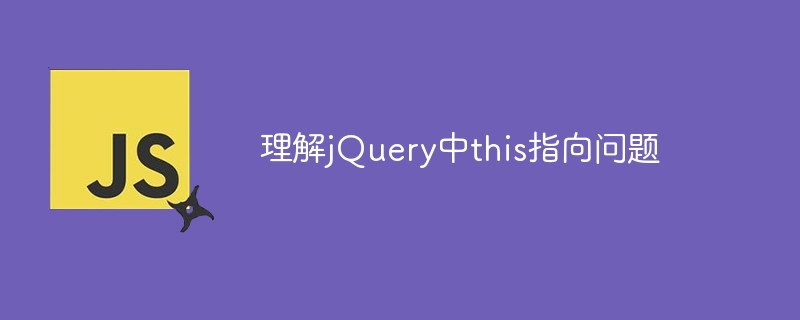Understanding the this pointing problem in jQuery
Feb 28, 2024 pm 09:27 PM
To understand the this pointing problem in jQuery, you need specific code examples
jQuery is a widely used JavaScript library that is used to simplify HTML document traversal, event processing, Animation and AJAX interaction. When using jQuery, you often encounter the problem of this point. This is because the this point in jQuery will change depending on the context, so it is important to understand this point. In the following content, I will introduce several common situations and illustrate the problem pointed to by this through specific code examples.
1. Top-level level
When this is used in the global scope of jQuery, this points to the window object. For example:
console.log(this); // 输出为window对象
2. Event handler
In the event handler, this points to the DOM element that triggered the event. For example:
$('button').click(function() {
console.log(this); // 输出为触发点击事件的按钮元素
});3. Use each method
When using each method to iterate a collection of jQuery objects, this points to the currently traversed element. For example:
$('li').each(function() {
console.log(this); // 输出为当前遍历的li元素
});4. Use the bind, call or apply method
If you use the bind, call or apply method to bind the context of the function, this points to the specified context object. For example:
function sayHello() {
console.log(this.name);
}
var person = { name: 'Alice' };
sayHello.call(person); // 输出为'Alice'5. this in arrow functions
In arrow functions, this points to the context when the function is defined, not the runtime context. For example:
function Person() {
this.name = 'Bob';
this.greet = () => {
console.log(this.name);
};
}
var person = new Person();
person.greet(); // 输出为'Bob'Through the above specific code examples, we can better understand the problem pointed to by this in jQuery. In actual development, understanding this pointer is very important for writing clear and maintainable code. I hope the above content will be helpful to you.
The above is the detailed content of Understanding the this pointing problem in jQuery. For more information, please follow other related articles on the PHP Chinese website!

Hot Article

Hot tools Tags

Hot Article

Hot Article Tags

Notepad++7.3.1
Easy-to-use and free code editor

SublimeText3 Chinese version
Chinese version, very easy to use

Zend Studio 13.0.1
Powerful PHP integrated development environment

Dreamweaver CS6
Visual web development tools

SublimeText3 Mac version
God-level code editing software (SublimeText3)

Hot Topics
 Usage of typedef struct in c language
May 09, 2024 am 10:15 AM
Usage of typedef struct in c language
May 09, 2024 am 10:15 AM
Usage of typedef struct in c language
 How to solve variable expected in java
May 07, 2024 am 02:48 AM
How to solve variable expected in java
May 07, 2024 am 02:48 AM
How to solve variable expected in java
 Advantages and disadvantages of closures in js
May 10, 2024 am 04:39 AM
Advantages and disadvantages of closures in js
May 10, 2024 am 04:39 AM
Advantages and disadvantages of closures in js
 C++ smart pointers: a comprehensive analysis of their life cycle
May 09, 2024 am 11:06 AM
C++ smart pointers: a comprehensive analysis of their life cycle
May 09, 2024 am 11:06 AM
C++ smart pointers: a comprehensive analysis of their life cycle
 There are several situations where this in js points to
May 06, 2024 pm 02:03 PM
There are several situations where this in js points to
May 06, 2024 pm 02:03 PM
There are several situations where this in js points to
 Can the definition and call of functions in C++ be nested?
May 06, 2024 pm 06:36 PM
Can the definition and call of functions in C++ be nested?
May 06, 2024 pm 06:36 PM
Can the definition and call of functions in C++ be nested?
 Why can't click events in js be executed repeatedly?
May 07, 2024 pm 06:36 PM
Why can't click events in js be executed repeatedly?
May 07, 2024 pm 06:36 PM
Why can't click events in js be executed repeatedly?








